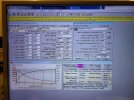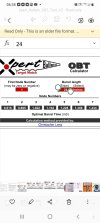Once you have your QL set up and trued to actual velocities for a range of charge weights at the bullet seating depth you have determined is
optimum, you adjust your Ba Burn rate until you history match your actual velocities. You need to be using fire formed brass too.
Then you will want to look at the milli seconds of bullet exit time from your barrel to try to pick an optimum bullet exit time or velocity node that gives you good groups or will give you good groups with some fine tuning from there.
Here's the process to get to a starting point for doing OCW method fine tuning, or to run some Audette or Satterlee curves or all of the above.
I view this method using QL as a way to get to a good starting point for fine tuning.
First read over this paper by Chris Long to understand his theory and approach. It is Attached below as Chris Long OBT Theory
Then use this spread sheet or the table to enter your specific bbl. length from chamber to end of rifling to get the OBT nodes Long developed
from harmonics work. You will see up to 7 nodes per barrel length you can choose from depending on the pressures and velocities you are able to safely achieve in your specific rifle system at the specific charge weight and bullet weight you are using. I have rarely ever seen any way I could use a node 7 for any loads I shoot. Its way too fast for my set up. (If you are running a can, it may affect your "effective barrel length")
You can either use the attached table in pdf or the excel spreadsheet that is available with your barrel length input into it.
The excel spreadsheet is available for download here:
Here is an example output file I ran for my .338 LM to look at what charge weight I can most nearly match up to Long's OBT node for my 25.25 inch
bbl. Go to the end of the document to see the muzzle exit bbl time compared to Node 6 for a 25.25 inch bbl. from Long's work. It is attached below.
This table is the one output in QL. It is the 8th button at top from left and looks like a minature table or tablet.
Now, these tables and the spreadsheet are likely only valid for carbon steel barrels, or possibly stainless barrels. They probably do not work for
Carbon Fiber because they are based on pressure and sound wave travel times in carbon steel.
This as I have said is just to get a good starting point on load development. In my mind, one still needs to fine tune from here using one's preferred method. But it gets you close in theory. Perhaps for a .223 with very low amounts of harmonics it is very accurate. For big caliber magnums with
different barrel tapers, it may just be another tool to get you into the ball park.
optimum, you adjust your Ba Burn rate until you history match your actual velocities. You need to be using fire formed brass too.
Then you will want to look at the milli seconds of bullet exit time from your barrel to try to pick an optimum bullet exit time or velocity node that gives you good groups or will give you good groups with some fine tuning from there.
Here's the process to get to a starting point for doing OCW method fine tuning, or to run some Audette or Satterlee curves or all of the above.
I view this method using QL as a way to get to a good starting point for fine tuning.
First read over this paper by Chris Long to understand his theory and approach. It is Attached below as Chris Long OBT Theory
Then use this spread sheet or the table to enter your specific bbl. length from chamber to end of rifling to get the OBT nodes Long developed
from harmonics work. You will see up to 7 nodes per barrel length you can choose from depending on the pressures and velocities you are able to safely achieve in your specific rifle system at the specific charge weight and bullet weight you are using. I have rarely ever seen any way I could use a node 7 for any loads I shoot. Its way too fast for my set up. (If you are running a can, it may affect your "effective barrel length")
You can either use the attached table in pdf or the excel spreadsheet that is available with your barrel length input into it.
The excel spreadsheet is available for download here:
Here is an example output file I ran for my .338 LM to look at what charge weight I can most nearly match up to Long's OBT node for my 25.25 inch
bbl. Go to the end of the document to see the muzzle exit bbl time compared to Node 6 for a 25.25 inch bbl. from Long's work. It is attached below.
This table is the one output in QL. It is the 8th button at top from left and looks like a minature table or tablet.
Now, these tables and the spreadsheet are likely only valid for carbon steel barrels, or possibly stainless barrels. They probably do not work for
Carbon Fiber because they are based on pressure and sound wave travel times in carbon steel.
This as I have said is just to get a good starting point on load development. In my mind, one still needs to fine tune from here using one's preferred method. But it gets you close in theory. Perhaps for a .223 with very low amounts of harmonics it is very accurate. For big caliber magnums with
different barrel tapers, it may just be another tool to get you into the ball park.


